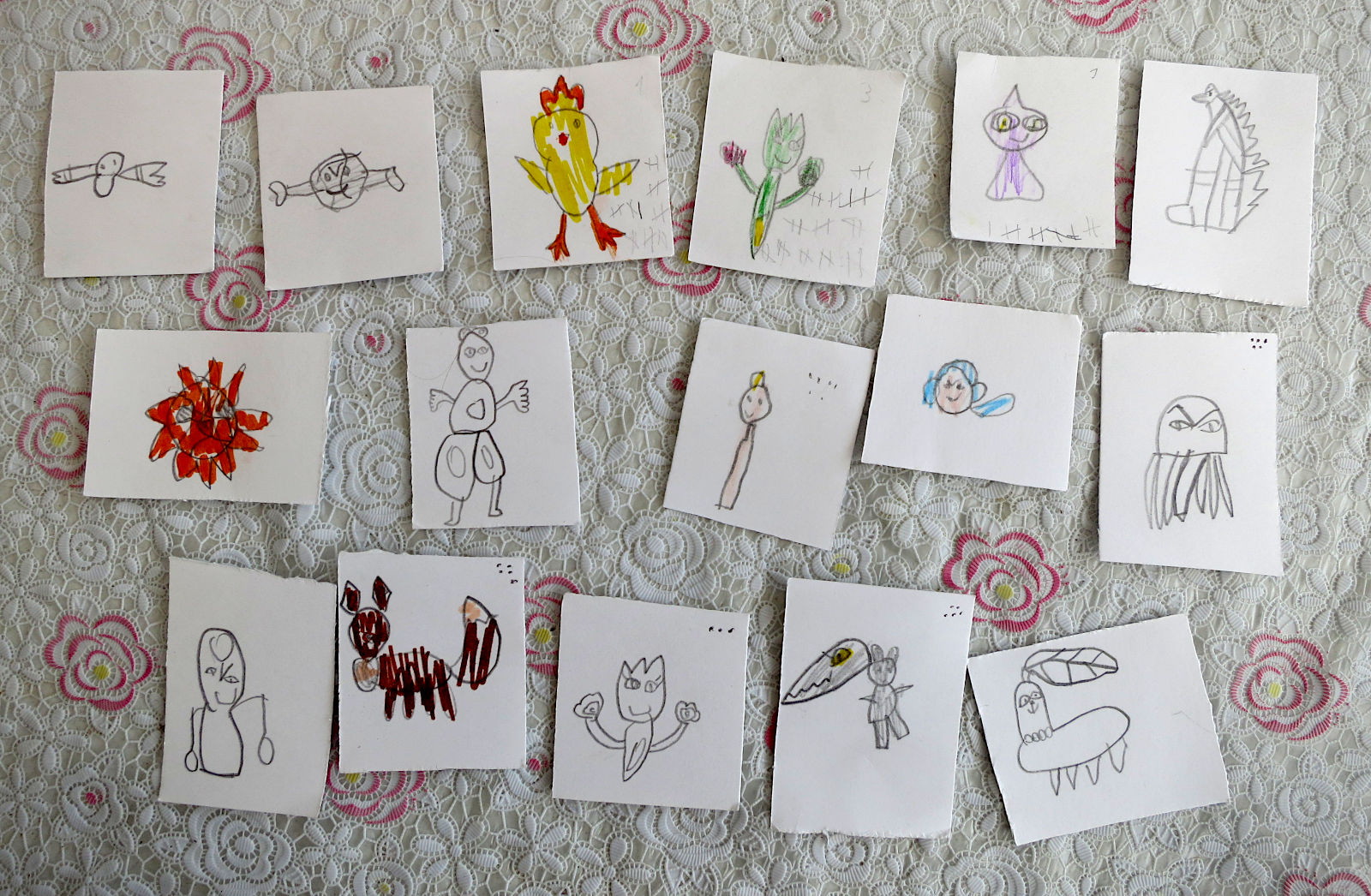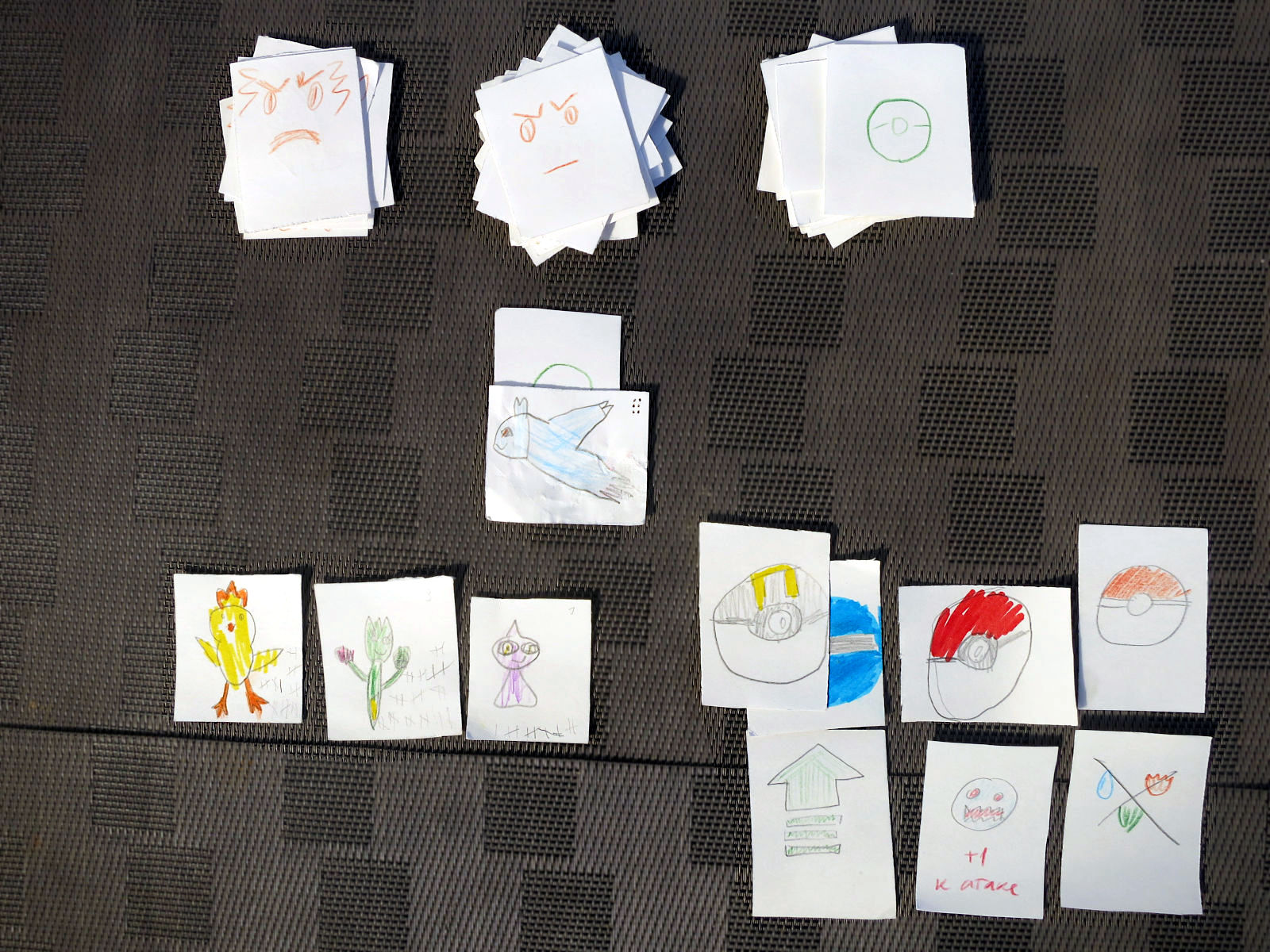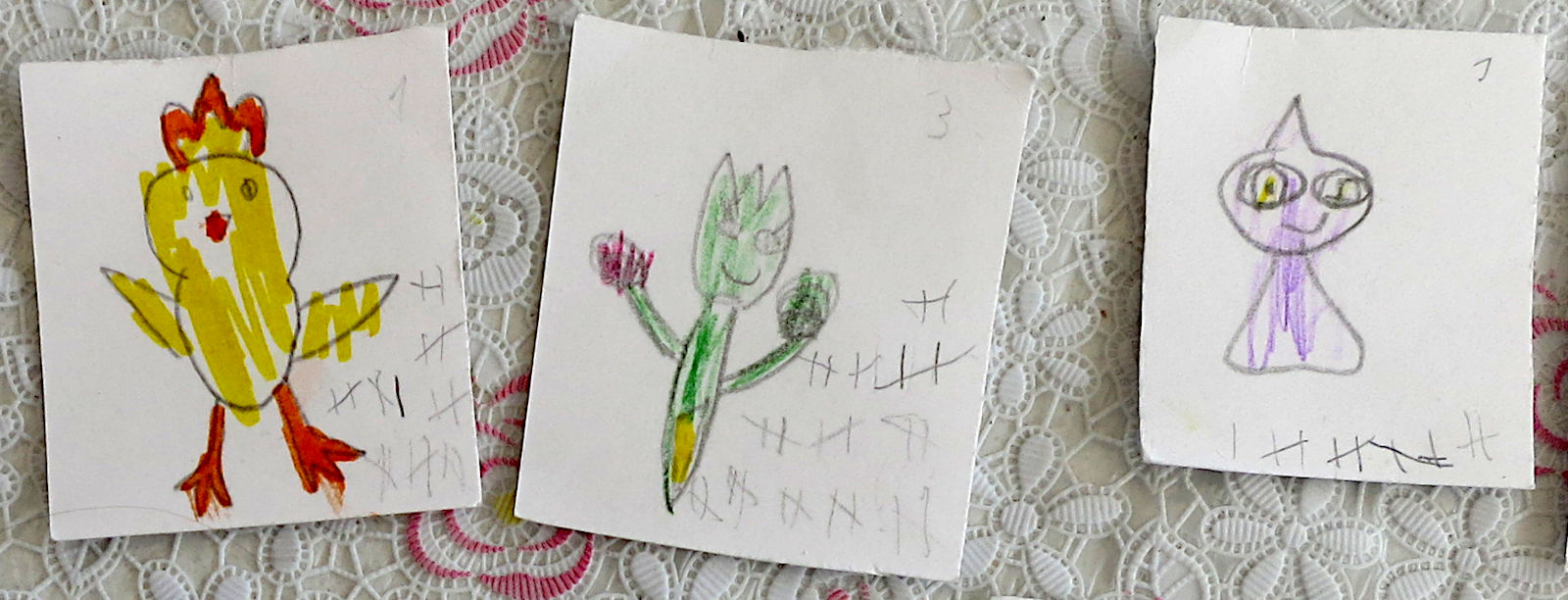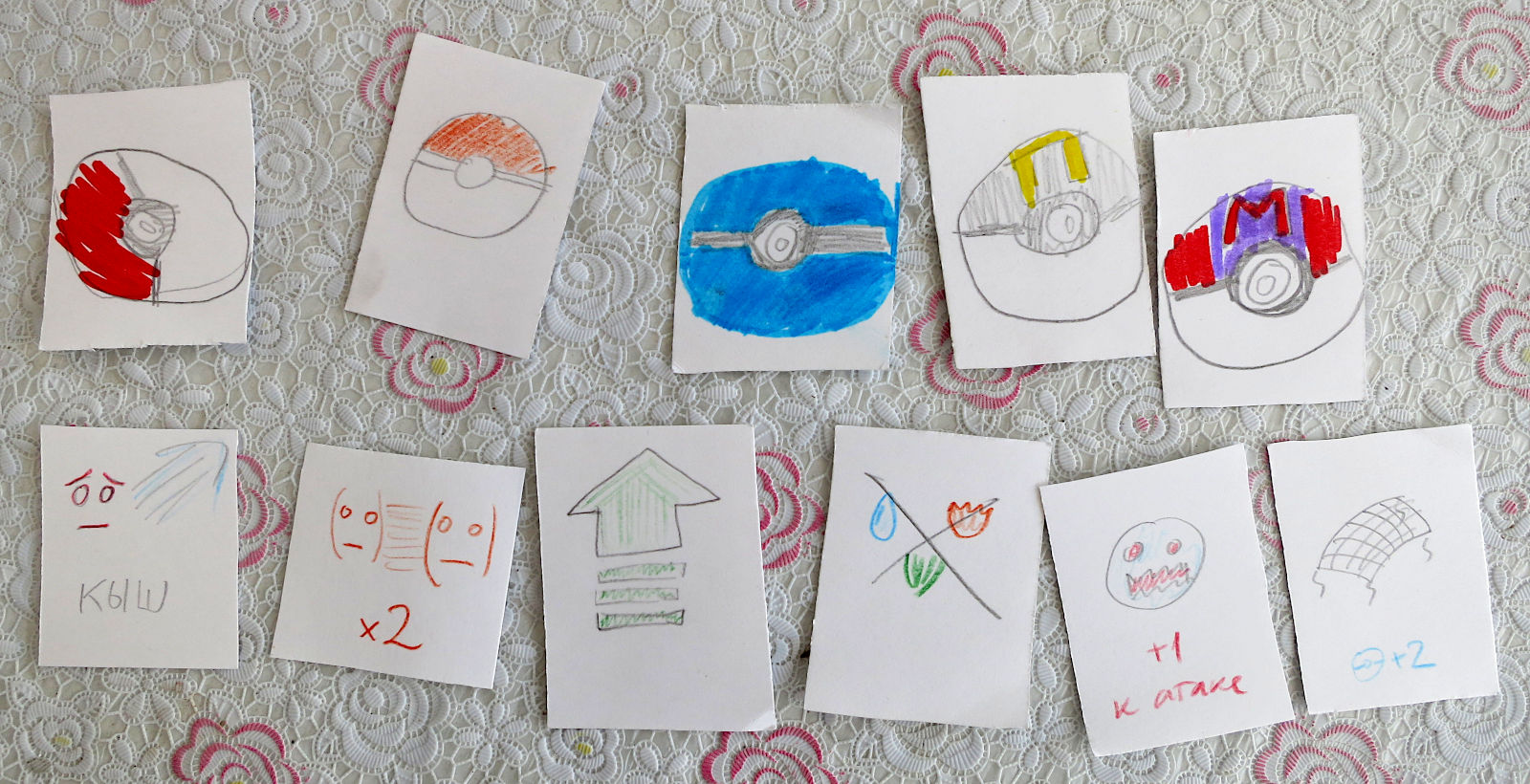Pokémon DIY Card Game
Preparing
For the game you would need a d6 dice (or an app like this one), a graphite and coloured pencils, and few sheets of thick white paper. A repeat game would require an eraser to remove old markings.
First you need to draw cards. It is an important part of the game: children would like to remeber or invent creatures, and make their own, not ready-bought, cards.
- 20+ regular pokemon cards
- 2+ legendary pokemon cards
- 10+ pokeball cards
- 10+ other item cards (see the list below)
In total, 45 cards at the least: two sheets of A4 paper should be enough, cut 4×6 into squares. Though you’d do better with 4-5 sheets.
On the flipside you would need to mark regular and legendary pokemon, and all the items (pokeballs and others alike). Come up with simple markings and quickly mark all the cards’ flipsides.

Every regular pokemon card should have dots corresponding to its Catch Rate (we look it up in a Pokedex app), according to the table:
| 255 | 1 |
| 200+ | 2 |
| 130+ | 3 |
| 90+ | 4 |
| 45+ | 5 |
| 1+ | 6 |
Legendary pokemon always have 7, you don’t need to draw these. For invented pokemon, roll a dice.
Game Start
Players receive one starter pokemon each (either special or a regular one) of level 1, and 1-2 pokeballs. A player can have any number of pokemon stored away, and only three in the game. They can swap pokemon outside a battle at any time. One can have any number of items.
Turn

Open a regular (wild) pokemon card and roll a d6 dice to find its level using the table below. A denotes a level of the weakest pokemon in battle, and Z is a level of the strongest one. The minimum level is obviously 1.
| 1 | A–1 |
| 2 | A |
| 3 | A+1 |
| 4 | Z–1 |
| 5 | Z |
| 6 | Z+1 |
To complicate the game a little, use 4=A+2, 5=Z–1, 6=Z.
Now the battle: roll the dice again.
| Level of a player’s pokemon compared to N, level of wild pokemon |
Number on the dice to win |
|---|---|
| N+2 or more | auto win |
| N+1 | 2+ |
| N | 4+ |
| N–1 | 6 |
| N–2 or less | auto loss |
When lost, a pokemon faints and skips the next battle. Another player’s pokemon enters the battle — and the opposing pokemon loses a level with each fight. That is, a level 7 pokemon defeats a player’s pokemon and fights the next one — but now with level of 6. The level can fall to 0, but not -1.
A player can run at any time. When escaped or lost, the wild pokemon should be shuffled back into the deck.
After a Battle

After winning, a player draws an item card from the deck (which they can use only on the next turn), and draws a stroke on all pokemons participating in the battle. If a pokemon didn’t attack a wild pokemon, they don’t get a stroke. Three strokes level up a pokemon.
If a difference in pokemon levels in a fight was 3 or more, a player’s pokemon gets two strokes. For difference of 6, three strokes; 9 gets four, and so on.
Catching a Pokémon
After a battle (no matter lost or won) you can throw a pokeball and try to catch a pokemon. To do that, roll a dice, and the number on it should not be less than number of dots on the pokemon card. If you didn’t defeat the pokemon, you would need to roll one greater.
For example, an undefeated legendary pokemon needs rolling 8 or more to be caught (which is obviously improssible with a d6). Using an ultra ball, you would need to roll 6. But if you’ve defeated the pokemon, 5 is enough. Finally, if you use a “+2 to catching” card, to catch with an ultra ball a defeated legendary pokemon, you need to roll 3 or greater — which gives 67% probability of catching it.
You can throw more pokeballs if the first did not work.
After catching a pokemon, write its base level on it — that’s the one determined with a dice roll before the battle. To avoid erasing these temporary markings in the next game, you might make a sleeve or something.
Legendary Pokémon
When the strongest pokemon in game reaches level 10, legendary pokemon can appear. They suddensly replace a wild pokemon on the field, when a dice roll for power shows 1, and the last pokemon wasn’t legendary. Alternatively, you can open a legendary pokemon every 6 turns, or by request.
A level of a legendary pokemon is d6+Z, where Z is the level of the strongest pokemon in the battle.
Goal
The game ends when all the legendary pokemon are caught. Also you can set a deadline (the game tends to last) or set a goal of catching a specific legendary pokemon.
Pokémon and Items

Types of pokeballs:
- poke ball
- master ball (always succeeds and then leaves the deck)
- ultra ball (+2)
- all other types (+1)
Types of items:
- +1 to attack (once a fight)
- +2 to catching (for one pokemon)
- level up (down strokes to a full level; once outside a battle)
- double (doubles the pokemon level)
- scare the pokemon away (during a battle; it leaves an item)
All battle items can be used simultaneously: for example, you can boost a pokemon with three cards “+1 to attach” at once. After using, shuffle them into the deck.
Modifications
Pokémon Types
Pokemon usually have a type: like, electric or water. You can add it to cards. Three to five would be best: for example, water, fire, grass and air. Or take the set from the TCG, although then you would need to consult the type chart each time.
Stronger type gives a pokemon an extra level when battling a pokemon with a weaker type.
Additionally you would need an item card “remove type” to remove type effects in a battle.
Multiple Players
When there are multiple players, they draw cards in turns. They can trade items outside of battles. If a new player joins mid-game, other players should provide her or him with a pokemon and a pokeball out of their own cards.
Players can battle each other. They place items they battle over. Then they battle each one’s strongest pokemon. After that — the second strongest, until all pokemon of a losing player have fainted. First turn makes the one who was proposed a battle.
(This has not beed playtested.)
Playing Outside
Instead of sitting home over a deck, you can go outside. Just hide pokemon cards in bushes or under stones, possibly taking into account their types. Hide items together with pokemon, possibly in pairs: pokeball + other item. Players should find and battle these pokemon by themselves, rolling their dice. A goal may be finding all hidden pokemon.
Addendums
Pokémon Level Table
Using the formula from the “Turn” section:
| in battle | 1 | 2 | 3 | 4 | 5 | 6 |
|---|---|---|---|---|---|---|
| 1—1 | 1 | 1 | 2 | 1 | 1 | 2 |
| 1—2 | 1 | 1 | 2 | 1 | 2 | 3 |
| 1—3 | 1 | 1 | 2 | 2 | 3 | 4 |
| 1—4 | 1 | 1 | 2 | 3 | 4 | 5 |
| 2—2 | 1 | 2 | 3 | 1 | 2 | 3 |
| 2—3 | 1 | 2 | 3 | 2 | 3 | 4 |
| 2—4 | 1 | 2 | 3 | 3 | 4 | 5 |
| 3—3 | 2 | 3 | 4 | 2 | 3 | 4 |
| 3—4 | 2 | 3 | 4 | 3 | 4 | 5 |
| 4—4 | 3 | 4 | 5 | 3 | 4 | 5 |
For the alternative formula with A+2:
| in battle | 1 | 2 | 3 | 4 | 5 | 6 |
|---|---|---|---|---|---|---|
| 1—1 | 1 | 1 | 2 | 3 | 1 | 1 |
| 1—2 | 1 | 1 | 2 | 3 | 1 | 2 |
| 1—3 | 1 | 1 | 2 | 3 | 2 | 3 |
| 1—4 | 1 | 1 | 2 | 3 | 3 | 4 |
| 2—2 | 1 | 2 | 3 | 4 | 1 | 2 |
| 2—3 | 1 | 2 | 3 | 4 | 2 | 3 |
| 2—4 | 1 | 2 | 3 | 4 | 3 | 4 |
| 3—3 | 2 | 3 | 4 | 5 | 2 | 3 |
| 3—4 | 2 | 3 | 4 | 5 | 3 | 4 |
| 4—4 | 3 | 4 | 5 | 6 | 3 | 4 |
Why not Pokémon TCG?
Me and my daughter are on a vacation at a sea, and she spends an hour every day staring into a small Nintendo 3DS screen playing OmegaRuby. When she isn’t, she thinks about the game. To get her off the screen, I decided to invent a card game. All I have are pencils and paper. A dice is obviously inevitable: until I bought a real one in a shop, I used an app.
A research has shown that there is just one pokemon card game, and it requires buying or drawing very detailed cards. And it has complex rules and too many numbers. My kid is six, and she wants to collect pokemon, not do math. Thus I made the rules as simple as possible, focusing on drawing, winning not too easily (because you value what you earned), and collecting creatures.
We continued to polish the rules during the game. Formerly pokemon levels were pre-determined, but then it became clear that doesn’t work when you pokemon keep growing. We had to use the dice for levels as well, and tweak the formula few times. Then, the kid preferred to raise a single pokemon out of the team, and the rest were in low levels. And the dice kept showing 6 for wild pokemon level, but 1 during a battle or for pokeballs. Fixing issues made the rules grow.
The game has succeeded: she plays the 3DS for half an hour now. But the rest of the time is devoted to the cards, which is not so good I guess. We had to install a time limit for playing this game as well. I’d recommend playing for no more than 40 minutes, so that you won’t fight after the game.
History
The rules above describe version 1.0 of the game. Changes from older versions will be documented here.
Authors
All rights for images, pokémon names and the “Pokémon” word itself belong to The Pokémon Company.
Everything else here is published under CC0 license. Idea by Ilya Zverev, with improvements by other people.